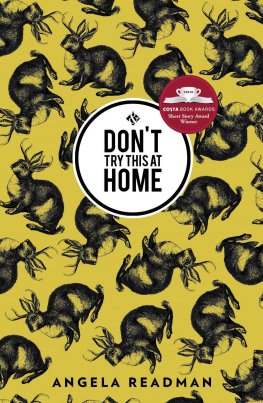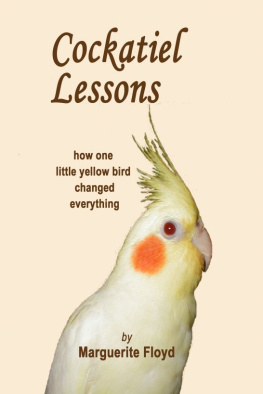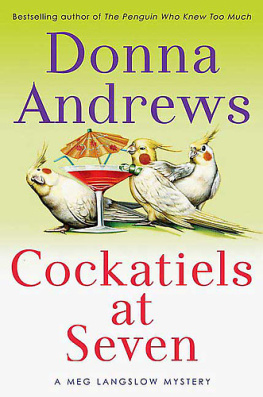Angela Davids - Cockatiels: A Guide to Caring for Your Cockatiel
Here you can read online Angela Davids - Cockatiels: A Guide to Caring for Your Cockatiel full text of the book (entire story) in english for free. Download pdf and epub, get meaning, cover and reviews about this ebook. year: 2011, publisher: Fox Chapel Publishing, genre: Children. Description of the work, (preface) as well as reviews are available. Best literature library LitArk.com created for fans of good reading and offers a wide selection of genres:
Romance novel
Science fiction
Adventure
Detective
Science
History
Home and family
Prose
Art
Politics
Computer
Non-fiction
Religion
Business
Children
Humor
Choose a favorite category and find really read worthwhile books. Enjoy immersion in the world of imagination, feel the emotions of the characters or learn something new for yourself, make an fascinating discovery.
- Book:Cockatiels: A Guide to Caring for Your Cockatiel
- Author:
- Publisher:Fox Chapel Publishing
- Genre:
- Year:2011
- Rating:4 / 5
- Favourites:Add to favourites
- Your mark:
- 80
- 1
- 2
- 3
- 4
- 5
Cockatiels: A Guide to Caring for Your Cockatiel: summary, description and annotation
We offer to read an annotation, description, summary or preface (depends on what the author of the book "Cockatiels: A Guide to Caring for Your Cockatiel" wrote himself). If you haven't found the necessary information about the book — write in the comments, we will try to find it.
Cockatiels: A Guide to Caring for Your Cockatiel — read online for free the complete book (whole text) full work
Below is the text of the book, divided by pages. System saving the place of the last page read, allows you to conveniently read the book "Cockatiels: A Guide to Caring for Your Cockatiel" online for free, without having to search again every time where you left off. Put a bookmark, and you can go to the page where you finished reading at any time.
Font size:
Interval:
Bookmark:


This group displays the special characteristics of the little parrots known as cockatiels. These slender birds have beautiful long tails and distinctive mobile crests.
P LAYFUL AND AFFECTIONATE, COCKATIELS ARE FINDING their way into more and more homes as adored pets. And they are the perfect parrot species for the first-time pet bird owner. Cockatiels are small parrotsbigger than budgies and lovebirds but about the size of the small conuresmuch smaller than African grey parrots and many other familiar pet birds. Cockatiels are generally easy to tame and not too costly to feed and cage (compared with larger parrots), and many cockatiels love to be handled and cuddled.
A Cockatiel Is a Parrot
Almost everyone can recognize parrots on sight. They have a distinctive appearance that includes feathers (of course!), a strong and sharply hooked beak, and feet that form an X, with two toes in front and two in backa pattern known as zygodactylous. When parrots walk, their short legs give them a characteristic swaying motion. Most people also know that cockatoos and cockatiels have a crest whereas the other parrots usually dont, and most know that cockatiels are smaller than cockatoos. But thats probably about all the average person knows about parrots, cockatoos, and cockatiels. And thats probably all youve ever needed to knowuntil now!
Cockatiels Are Cockatoos
Parrots are a large family, or major group, of birds known as Psittacidae, and there are approximately 350 living species. They have no close relatives, although some ornithologists (scientists who study birds) have suggested relationships with such diverse birds as doves, cuckoos, and swifts. Parrots have a long fossil history and have even been linked to dinosaurs. Today, parrots are found around the world in the tropics and subtropics, with most species in tropical North and South America, in Australia, and in nearby islands such as New Guinea and Indonesia. Even the southeastern United States once had a widespread native parrot, the Carolina parakeet, which became extinct almost a century ago but was once found from New York to Texas.
Of these 350 types of parrots, just 21 species (give or take one or two, depending on which expert you consult) are properly called cockatoos. Many ornithologists now place cockatoos in a separate family called Cacatuidae, with cockatiels being members of the subfamily Nymphicinae. These birds range from pinkish Galahs to solid-black palm cockatoos. All cockatoos are found only in southern Asia and Australia, with more than half the species found only on the continent of Australia; many species are restricted to a few small islands of Indonesia and the Philippines. Cockatiels are native to Australia, where they are widely distributed in the arid interior regions.

This magnificent Eleonora cockatoo is showing off her large and impressive crest. She is heavier-bodied than your cockatiel, with a shorter tail.
What Makes a Parrot a Cockatoo?
TO THE CASUAL OBSERVER, A COCKATOO IS A COCKATOO because she has a crest of erectile feathers on the crown of her head. The crest may be just a few feathers or many, long or short, and wide or narrow, but any cockatoo is likely to have a distinct crest. A few other parrots have crests, but these differ in structure (such as a few narrow, permanently erect feathers) or placement (such as being arrayed in a circle across the nape.) Cockatoos can also be identified by the lack of green feathers that are common in so many parrots. Andnot that you can tell by lookingcockatoos have gall bladders, whereas other parrots dont.
But Isnt a Cockatiel Different?
Cockatiels certainly dont look like typical cockatoos. A cockatiel is slender, has a long and pointed tail, and has a small, delicate body. Cockatoos generally are heavier bodied and have relatively short and square or rounded tails. The cockatiels color pattern also is very different. Well examine the cockatiel in more detail later, but lets just say that under those pretty gray feathers a cockatiel is similar to a cockatoo in bone and muscle structure, the presence of a gall bladder and a specific arrangement of arteries coming from the heart, and the absence of any blue or green coloration in the feathers.
In the past, many owners and authorsand even a few scientistsconsidered cockatiels to be intermediate between true parrots and true cockatoos, but this is no longer the case. Studies of their genetic material show that cockatiels really are highly distinctive cockatoos, not relatives of other Australian parrots. Your cockatiel is just a modified cockatoo who has adapted to a specific way of flying and behaving, and over time she developed her long, pointed tail and unique coloration.

Cockatiels often bond with each other as well as with their owners. These two dont even mind sharing a feed cup!
Fortunately for you, cockatiels differ from cockatoos in the very features that help make them excellent household pets. They are relatively small and have weaker beaks than most cockatoos do. Some can be taught to talk and whistle, but they do not produce the loud, frequent screams and cackles of some cockatoos. They can bond well with other cockatiels and with humans, have great personalities, and can breed easily in the home (although this is best left to experienced bird breeders). So you can easily understand why cockatiels are such popular pets!
The Cockatiels Scientific Classification
Family: Psittacidae (all the parrots)
Subfamily: Cacatuidae (all the cockatoos)
Genus: Nymphicus
Species: Hollandicus
No subspecies are recognizedcockatiels are pretty uniform in structure, size, and coloration across Australia.
(Note: some ornithologists split off the cockatoos as a full family, Cacatuidae, in which case the cockatiel would form a subfamily, Nymphicinae.)
The Wild Cockatiel
A wild cockatiel is typically between twelve inches and almost fourteen inches long and weighs just three to four ounces, although selectively bred pets may be significantly larger. The birds have a wingspan of about fourteen inches or more, and the central tail feathers (which help make the cockatiel such a distinctive cockatoo) are six to seven inches longabout half the total length of the bird. This means that the body of a cockatiel is only about six inches long (not much longer than that of a budgie), making it the smallest of all the cockatoos.
Coloration is relatively simple and consistent, although it varies between the sexes. In both genders, the overall coloration is gray. Each wing has a large white patch that covers the wing coverts (the small feathers at the bend or elbow area) and the secondary feathers, so a resting cockatiel exhibits a wide white band along the outer edge of the wing. Females have a paler lower back area than males do; the outer tail feathers, lower back, and area around the vent, or cloaca (the common opening through which the feces, urine, sperm, and eggs all pass), are finely barred with gray and yellowish white; the undersides of the outer tail feathers are largely yellow; and the undersides of the wings are faintly barred. In males, the lower back and tops of the long central tail feathers are pale gray but uniform, and the undersides of the tail feathers are nearly black.
Next pageFont size:
Interval:
Bookmark:
Similar books «Cockatiels: A Guide to Caring for Your Cockatiel»
Look at similar books to Cockatiels: A Guide to Caring for Your Cockatiel. We have selected literature similar in name and meaning in the hope of providing readers with more options to find new, interesting, not yet read works.
Discussion, reviews of the book Cockatiels: A Guide to Caring for Your Cockatiel and just readers' own opinions. Leave your comments, write what you think about the work, its meaning or the main characters. Specify what exactly you liked and what you didn't like, and why you think so.













